-
Car Reviews
- All reviews
- Midsize SUVs
- Small cars
- Utes
- Small SUVs
- Large SUVs
- Large cars
- Sports SUVs
- Sports cars
- Vans
Latest reviews
- Car News
-
Car Comparisons
Latest comparisons
- Chasing Deals
With its new platform, finessed interior and improved hybrid-led powertrains, the impressive new Lexus NX slams the door on its unremarkable predecessor
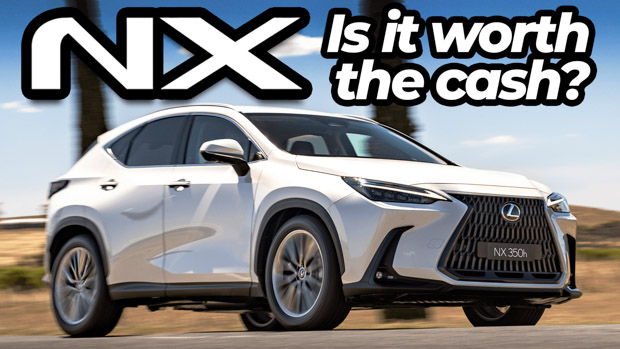
The Lexus NX is by far the Japanese luxury brand’s best-selling vehicle in Australia – and the world. Locally, every third NX transaction sees a buyer take home the right-sized, mid-sized NX crossover that’s a bit smaller than a BMW X3 or Audi Q5 but more practically-sized than an X1.
Australian buyers seeking a premium SUV clearly like this package, which explains why this all-new, second-generation NX looks quite familiar … from the front, at least. A radically rethought taillight design, script-based Lexus badging, much-improved new interior tech, a longer warranty and a shift to a much more rigid platform all herald that this is no facelift.
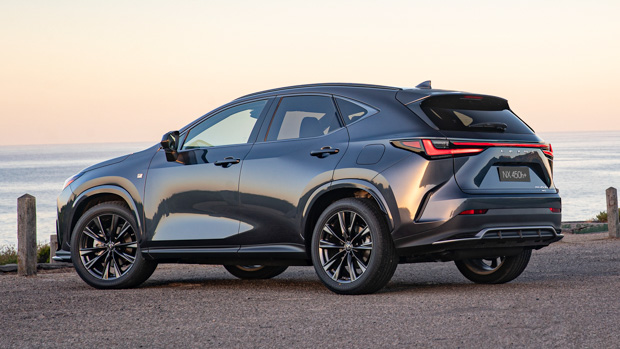
Far from it: armed with 17 feature-packed variants spanning a broad range from a relatively utilitarian NX 250 base model at circa-$70,000 through to this marque’s first plug-in hybrid, the $89,900 NX 450h+, there should be an NX that appeals to just about everybody.
In danger of being lost in the cacophony of changes outside and in is that the NX, which now shares the ES, Camry, Kluger and RAV4’s excellent GA-K modular platform, also introduces a brand-new 2.4-litre turbo engine that is a star performer.
But, classically for Lexus, it is actually the workhorse petrol-electric hybrid engine that shines brightest, with the NX 350h clearly marking itself out as the most balanced powertrain for nearly everybody who needs this car.
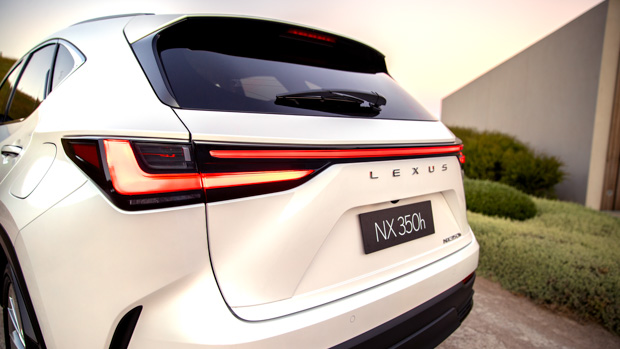
Then it’s just a matter of choosing front-wheel drive or all-wheel drive – and a spec level from the decently-equipped if not lavish Luxury, the athletic F Sport, or the opulent Sports Luxury. Not an uncomplicated range, we emerged from the launch with two favourites.
These were the NX 350h AWD Luxury with Enhancement Pack 1 ($73,400), what with its cushioning high-profile tyres and 18-inch wheels, and the very well-equipped NX 350h AWD F Sport with Enhancement Pack 2 ($83,900) – the final step before moving onto the plug-in hybrid.
Speaking of, we’ll have a review in two days’ time on the fascinating new NX 450h+.
The first choice you’ll need to make when ordering an NX – and facing a circa-four month wait for the popular new luxury SUV – is what engine suits you.
Two are available with front-wheel drive (FWD) which will suit most Australians; three are all-wheel drive (AWD) only, and one – the NX 350h hybrid – can be had with FWD or AWD.
Sitting at the entry point to the lineup is a new NX 250, which ditches the first-gen NX’s boosty 2.0-litre turbocharged petrol engine rather disappointingly for a (newer) 2.5-litre naturally-aspirated petrol making 152kW and 243Nm, shared with the ES 250 sedan, plus Toyota’s RAV4 and Camry.
It’s a fine engine, paired with an intelligent and smooth eight-speed torque converter automatic, but it certainly needs a rev to motivate the NX 250’s 1705kg kerb weight and you hear it in the process – a marked contrast to this SUV’s otherwise hushed cabin.
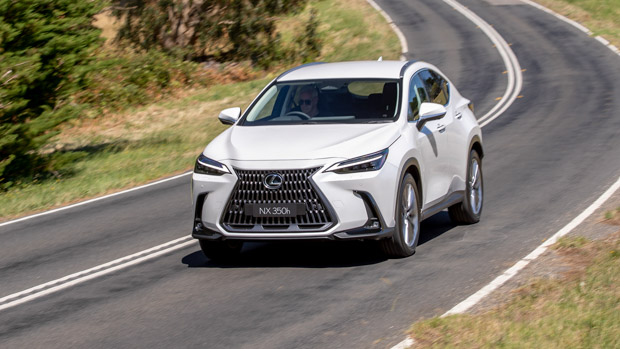
We could live with it, but the NX 250 doesn’t feel overtly luxurious; it leaves those duties to the pair of ‘350’-badged vehicles in the lineup. These cars share a number on their attractive tailgates, but they diverge very clearly in style and purpose.
First, to the NX 350: the fact this is an F Sport-only offering gives a hint at the warmth of its performance bent. This is, in fact, a turbo: a new 2.4-litre four-cylinder unit, in fact, producing a very decent 205kW of power and 430Nm of torque. Feisty, even frenetic off the line, the NX 350 is suitably AWD-only.
This means the NX 350 doesn’t have a direct rival from Audi, BMW or Mercedes-Benz, all of whom equip their two-litre petrol SUVs with less than 200kW of power – and it offers a pleasant step before heading up to the 227kW (non-turbo) plug-in hybrid.
Unlike the stiff-riding yet wallowing first-gen NX we never warmed to, this Lexus SUV now has a chassis that can cope with the titillating effects of 430Nm of torque and a flat 7.0-second 0-100km/h time. In fact, it’s so good you want to push on.
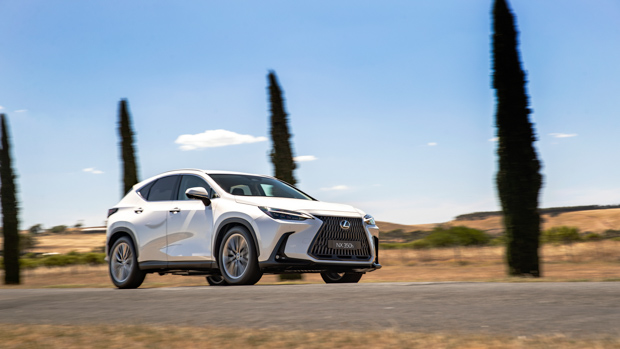
Settled, controlled, grippy and tractable, the NX 350 takes the base 250’s ride/handling attributes and gives it some fire. Even the 20-inch wheels, in danger of ruining the entry model’s excellent compliance on 18-inchers, is maintained thanks to adaptive dampers.
The NX 350 turbo in particular makes its AWD configuration obvious, its eight-speed auto enthusiastically directing torque rearward for some genuine RWD-style push from corners – not bad for a transverse setup. And the steering’s quick, and direct, and delivered through a pleasantly small perforated leather steering wheel – even if the tiller’s not fizzing with feel.
As good as the turbo is, though, the hybrid’s better. Sure, the NX 350h trails the turbo by 0.7sec in the benchmark 0-100km/h sprint but the electric torque is so overwhelmingly evident you’re hard-pressed picking up the slack – though the hybrid is best as a tri-motor AWD with the electrified rear axle.
Though the front-drive hybrid will suit most Australians fine, the drivers among us can absolutely feel the input from the AWD version’s rear motor that gives a pleasant kick from the rear in fast country-road cornering.

It feels every bit as quick as the turbo until eight-tenths, which is as far as most buyers will take their NX – even if the NX 350 is capable of just a bit more.
The boon, of course, is that the hybrid uses about half the fuel on the same stretch of road as the turbo, providing the near-nirvana of electrified torque while slashing running costs every day.
No surprise then that we expect the hybrid to mirror its Toyota RAV4 cousin in possessing the longest wait lists. If you’re on the fence, get in the queue.
It might be an impatient wait, but at least once you take delivery of an NX you can enjoy the hushed serenity of its ride – even on big 20-inch wheels it’s still fairly quiet on coarse chip in the cabin.
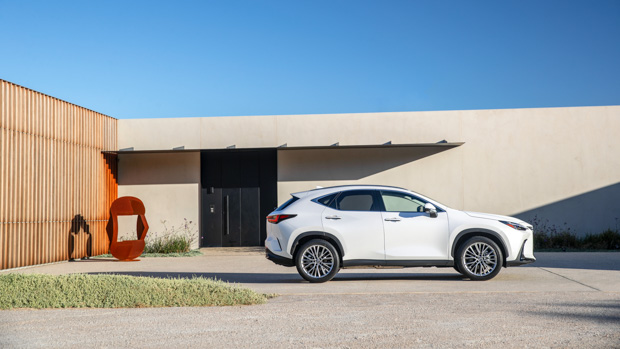
A number of readers asked us about noise at full throttle – it’s fairly pronounced in the NX 250, though it is more hushed in the other powertrains. The same is really true for any combustion engine – and at this stage, there is no all-electric NX (unlike the BMW X3, which recently gained a full-EV variant in Australia).
Lexus has improved the intelligence of its safety systems in a number of models lately, and the NX benefits from these smarts: in particular, the standard lane trace assist in the NX hews the vehicle to the centre of the lane on motorways without being too intrusive in town.
Likewise, the adaptive cruise control’s operation is judder-free and the standard reversing AEB works – confirmed by us – while there is forwards and junction AEB too that detects cyclists and pedestrians.
That said, there is still room for improvement on safety: the NX has fine blind spot monitoring in the mirrors, though it trails its Genesis GV70 rival for innovation here. The Genesis has camera-driven blind spot monitoring in the digital driver’s display that trumps a sensor-based system.
The new NX’s exterior design may, on the whole, not be revolutionary – but the cabin is another story. Gone is the touchpad-driven infotainment system liked by some owners but loathed by many commentators, replaced by an appropriately-2020s widescreen touchscreen with far snappier processing power backing it up.
Long-time Lexus fans will be pleased that the luxury brand has not thrown the baby out with the bathwater: key marque strengths like tasteful colourways, soft materials and generally high material and build quality have been retained in this SUV.
One of the four examples of NX we tested at length at the model’s launch on Victoria’s Mornington Peninsula had a light buzzing from the driver-side B-pillar, but none from the remainder sported any similar annoyance.
The NX has a relatively modest hip-height for an SUV ensuring entry and egress is decent rather than truck-like, but once seated the view out is good. We’re pleased that Lexus have not eliminated the NX’s large side mirrors that help with visibility and the glasshouse is quite conventional.
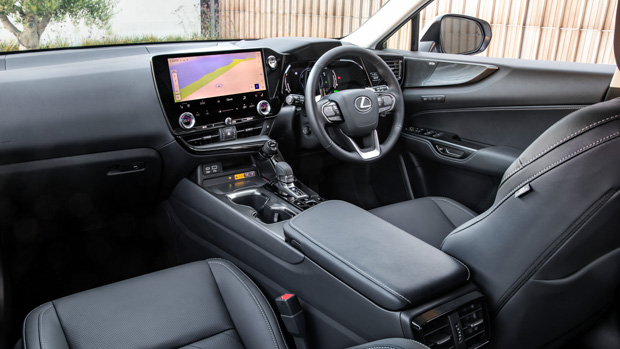
Speaking of seats, F Sport grades get the best pews with more aggressive bolstering – though with attention-to-detail shown in shoulder cut-outs making arm movements easier. Additionally, the F Sport chairs have a slightly more aggressive under-thigh angle, making them more supportive for longer-legged folk.
The chairs found in other variants also offer good levels of support, but we twisted in our seat once or twice over a few hundred kilometres.
As a rule of thumb, the F Sport and Sports Luxury variants benefit from fan-cooled, heated geniune leather while the unnamed base grade and Luxury make do with artificial leather (vinyl) and no seat cooling – despite the fact that they need ventilation the most.
It’s a shame that we got a little sweaty in the NX 350h AWD Luxury we tested, because that car, with its powerful tri-motor hybrid and cushioning 18-inch wheels, is basically the ideal spec … but on any kind of warm day, you’ll want a variant with cooled leather.

Unfortunately, that means accepting big 20-inch wheels with much lower-profile tyres, but at least the F Sport’s well-tuned adaptive dampers compensate for the deterioration in ride comfort. We didn’t spend enough time in a Sports Luxury to comment on whether its fixed dampers do the same.
Anyway, we digress – though our point highlights the fact that while the 2022 NX has 17 different variants in Australia, it lacks a perfect one.
Lexus is a good sport about offering interesting interior colours, though, and the various NX trims offer choices between black, hazel brown, deep red, black/red, and black/white interiors. Base cars have black lacquer trim, the F Sport scores aluminium, while the Sports Luxury gets attractive black open-pore wood inserts.
Back to the technology: there’s again a split between base/Luxury and F Sport/Sports Luxury here, with the former scoring a 9.8-inch touchscreen and the latter pair upgrading to the full-size 14.5-inch screen that really fills the driver-orientated dashboard slate.
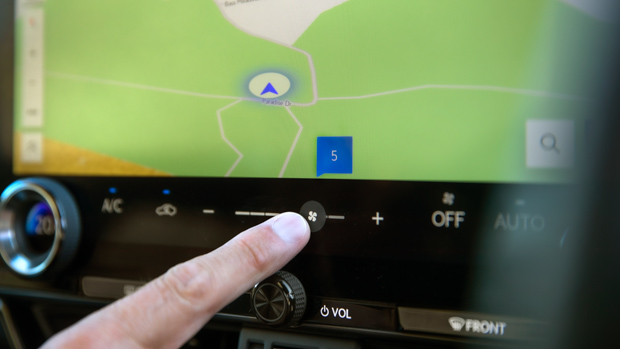
That said, the smaller screen doesn’t feel that underdone (a la the Volkswagen Touareg’s base screen), given the resolution is still very high and the software is snappy – but the full-size screen is really something to behold.
Cleverly integrating displays in the physical temperature knobs – there’s a volume knob, too – the screen always features a thin menu for climate controls and shortcuts on the driver’s side, but the main pane is customisable. We preferred to leave this on Apple CarPlay for Waze or on the NX’s own navigation, which looks great.
Frustratingly, this SUV was meant to have a wireless implementation of CarPlay and Android Auto – there were technical difficulties in making this work in Australia, and it hasn’t been delivered by launch. The hardware to enable this is present and Lexus hopes to add wireless smartphone mirroring to all new NX examples by software update in future.
Two stereos are available: a 10-speaker base stereo that we’d rate as pretty good, with clear mids and trebles, but the 17-speaker Mark Levinson premium audio system found behind the Enhancement Pack 2 option box increases clarity further while also pumping up the bass. Music fans will want the ‘Mark Lev’ but we were quietly impressed with the base unit.
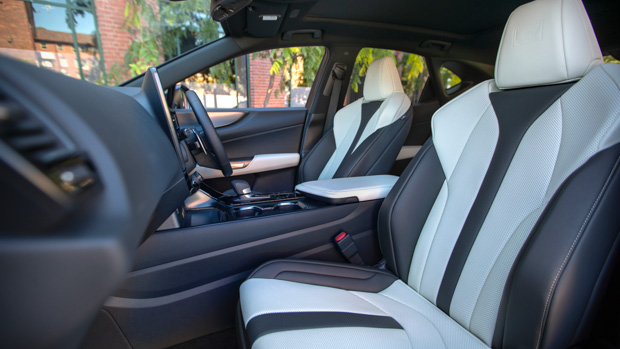
Lexus has delivered a real improvement in the second row despite barely increasing the physical size of the NX – so packaging is impressive. Generous legroom and headroom for six-footers in row two, plus comfortable seating, air vents and soft-touch materials, means this is a usable vehicle for four adults in total.
Storage is pretty good, with midsize cupholders between the seats up front, a decent box between the seats (though there’s no hidden cosmetic mirror in the centre console anymore), and door bins that will take a large water bottle. In the back, there’s also a flip-down armrest with cupholders – and this car has 4 USB-C ports for device charging.
Boot space is 520 litres across the range, with a big, square boot behind a standard power tailgate. No NX has a spare wheel, with all variants scoring BMW-style run-flat tyres instead.
Lexus recently extended its Australian new car warranty to five years with unlimited kilometres – matching Mercedes-Benz, Volvo, Jaguar Land Rover and Genesis … and parent brand Toyota – and this coverage applies to the new NX.
Most NX buyers are welcomed into Lexus’s junior-tier Encore membership programme – only the plug-in hybrid attracts full Encore Platinum benefits. All cars have three years of capped price servicing with a loan car delivered each time.
With intervals set at 12 months/15,000km, the first three years/45,000km of servicing totals $1485 with each maintenance stop pegged at $485 for every engine, hybrid or non-hybrid, AWD or FWD.
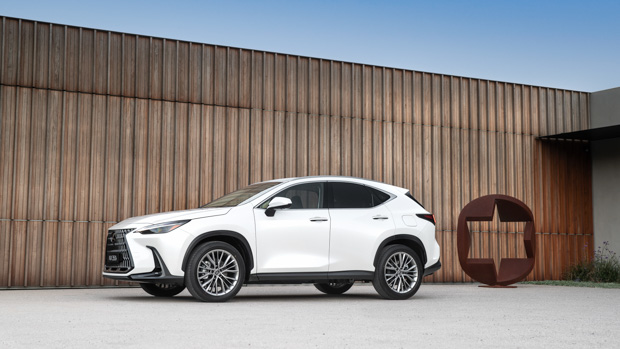
That price isn’t too bad, but it’s worth noting that every key rival to this vehicle offers at least five years of capped price servicing while five years/50,000km of maintenance is gratis for the Genesis GV70.
Fuel consumption varies considerably based on the engine that you opt for. On a test loop that biased fast country-road driving, we averaged 8.5L/100km in the NX 250 and 11L/100km in the NX 350 turbo … while returning a staggeringly low 5.5L/100km in the NX 350h hybrid despite a heavy right boot.
We’ve based our score on the NX 350h hybrid’s fuel consumption given it is expected to be the volume seller.
Surely a contender for 2022’s most-improved car award, the second-generation Lexus NX is finally a luxury SUV we feel is worthy of close consideration.
There is no doubting that the first-gen NX was a huge success for Lexus – it’s the brand’s most popular car – but it distantly trailed the IS and GS sedans (even the front-drive ES) for dynamics.
But no longer: while it’s not a natural sports car, there is a subtle athleticism to the new Lexus NX that makes each drive much more pleasant.
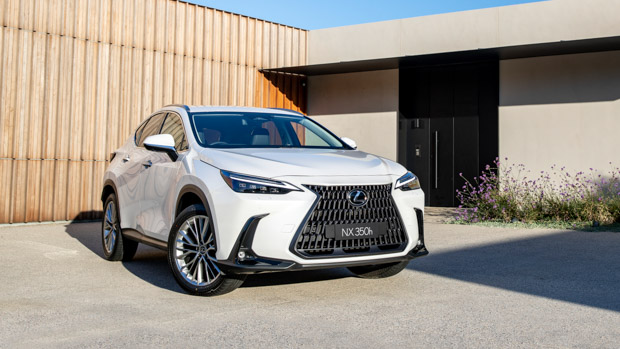
Improvements to the body control and ride quality are night-and-day, while the NX finally upgrades to an interior that feels like it belongs in the 2020s!
But Lexus knows it’s a lot better, which is why this car isn’t cheap. You’re looking at ninety grand on the road for a full-fat version (and that’s before you look at the new plug-in hybrid), yet orders are already stretching to four months.
At least there’s that new five-year warranty and this brand’s long-prized reputation for reliability is nothing to sneeze at.
There’s no doubt that if we needed a relatively compact, yet midsize, luxury SUV, the Lexus NX would be on our shortlist.
Variant tested F SPORT + EP2 HYBRID AWD
Key specs (as tested)
About Chasing cars
Chasing Cars reviews are 100% independent.
Because we are powered by Budget Direct Insurance, we don’t receive advertising or sales revenue from car manufacturers.
We’re truly independent – giving you Australia’s best car reviews.
The estimate provided does not take into account your personal circumstances but is intended to give a general indication of the cost of insurance, in order to obtain a complete quote, please visit www.budgetdirect.com.au. Estimate includes 15%^ online discount.
^Conditions Apply
Budget Direct Insurance arranged by Auto & General Services Pty Ltd ACN 003 617 909(AGS) AFSL 241 411, for and on behalf of the insurer, Auto & General Insurance Company Limited(ABN 42 111 586 353, AFSL 285 571).Because we don’t know your financial needs, we can’t advise you if this insurance will suit you. You should consider your needs and the Product Disclosure Statement before making a decision to buy insurance. Terms and conditions apply.
Indicative quote based on assumptions including postcode , 40 year old male with no offences, licence suspensions or claims in the last 5 years, a NCD Rating 1 and no younger drivers listed. White car, driven up to 10,000kms a year, unfinanced, with no modifications, factory options and/or non-standard accessories, private use only and garaged at night.
^Online Discounts Terms & Conditions
1. Discounts apply to the premium paid for a new Budget Direct Gold Comprehensive Car Insurance, Third Party Property Only or Third Party Property, Fire & Theft Insurance policy initiated online on or after 29 March 2017. Discounts do not apply to optional Roadside Assistance.
2. Discounts do not apply to any renewal offer of insurance.
3. Discounts only apply to the insurance portion of the premium. Discounts are applied before government charges, taxes, levies and fees, including instalment processing fees (as applicable). The full extent of discounts may therefore be impacted.
4. We reserve the right to change the offer without notice.